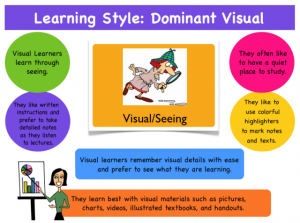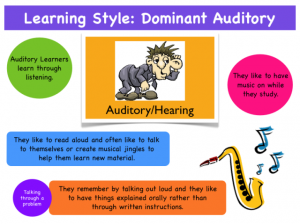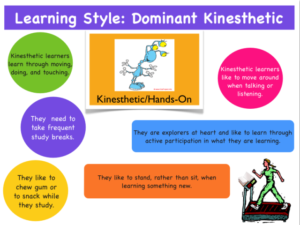If you had to learn something new, which would you prefer? To watch a video about it, listen to someone explain how to do it, or have someone show you what to do while you did it? What about your child…do you know? The 1st method is visual; the 2nd is auditory; and the 3rd tactile or kinesthetic. Each person acquires and processes information in a different way.
These preferences could occur independently, or in various combinations. They may change over time, and become integrated with age. Eventually, most persons will identify a preferred modality, but will use a variation of sensory styles for different activities. Reflect briefly on how you take in and process information in various situations and learning opportunities. Do you use one sense predominantly, or do you change modality based on the activity or learning event? How about your son…your daughter?
There are different approaches to the topic of learning styles, as well as, some controversy about the actuality of learning styles. Daniel Willingham argues that they do not exist, but rather the differences we see in the way children learn is because they come from different backgrounds, have varying experiences and interests. Regardless of what we call them, these sensory perceptions affect the way children learn. During my thirty plus years as an educator, I have witnessed it in my students.
Suzie walked into my therapy room, one day, and seeing a story book on the table, quickly plopped down into the chair. Eyes sparkling, she looked at me and asked, “Are you going to tell us that story?” Bobby, who followed her into the room, hastened to the shelves with the games. “Can we play a game today? Ooh, ooh, this one with the picture cards!” But Simon just sauntered from one area of the room to the next, picking up a toy here, opening a book there, or fiddling with the writing instruments.
After a breathing exercise, we started our session with a movement activity, progressed to a sit-down hand-eye coordination/muscle strengthening task with eye patches, and finished with a listening (auditory processing) lesson incorporating the story. As they left, Suzie smiled at me and remarked, “That was fun!” Bobby asked, “Are you picking us up tomorrow?” “Yea, what time?” piped Simon. My session data that day showed progress for all three students.
So mommies, as you help your children with homework, or explain an idea or concept during your daily life activities, how do you involve all their senses? Share your methods in the comments section below.




Hello,
this was very helpful.
I’m a teacher and I really needed a quick and brief view of learning styles.
So, thanks again
Haya
Thanks, Haya.
Teaching can be challenging at times. Feel free to stop by anytime.